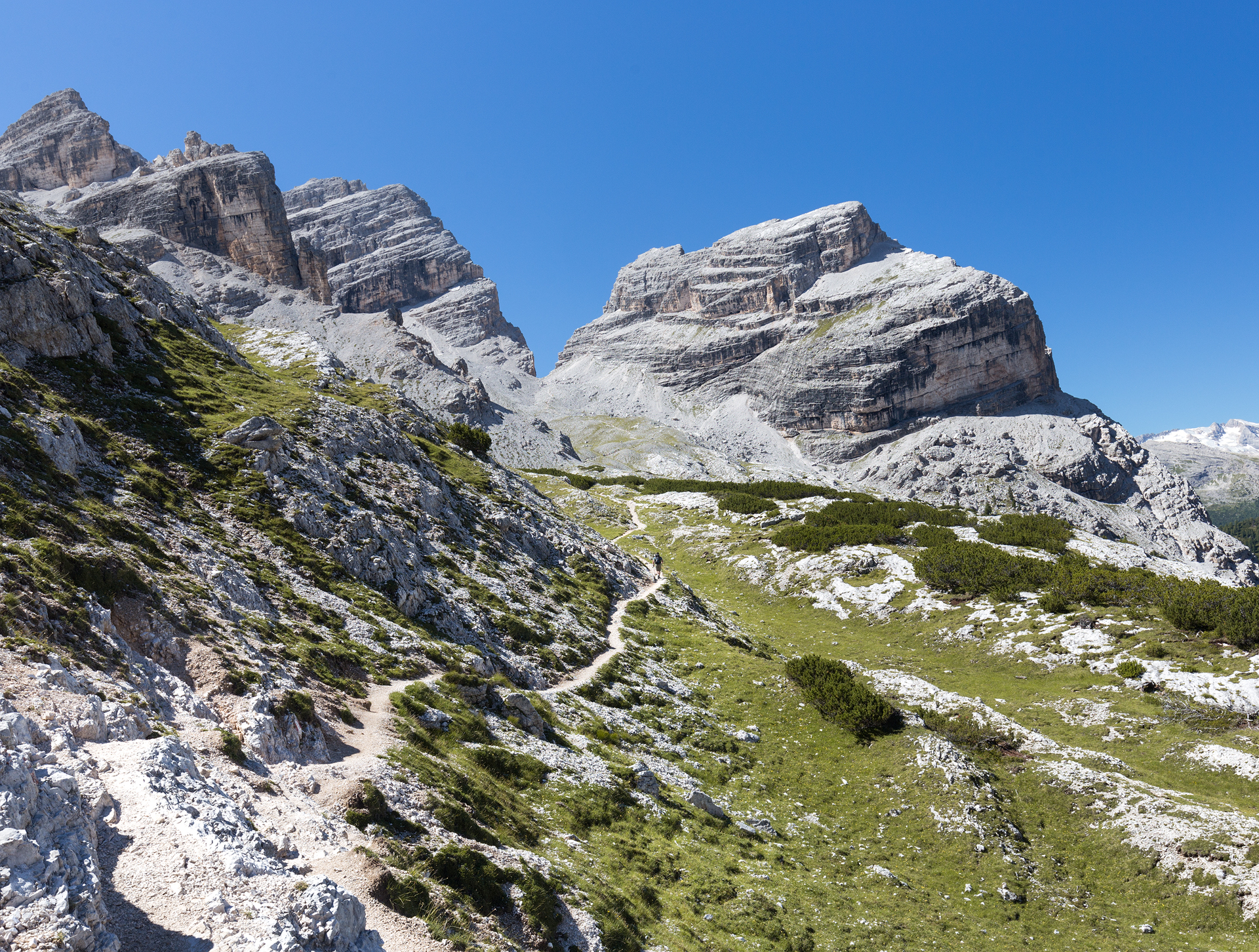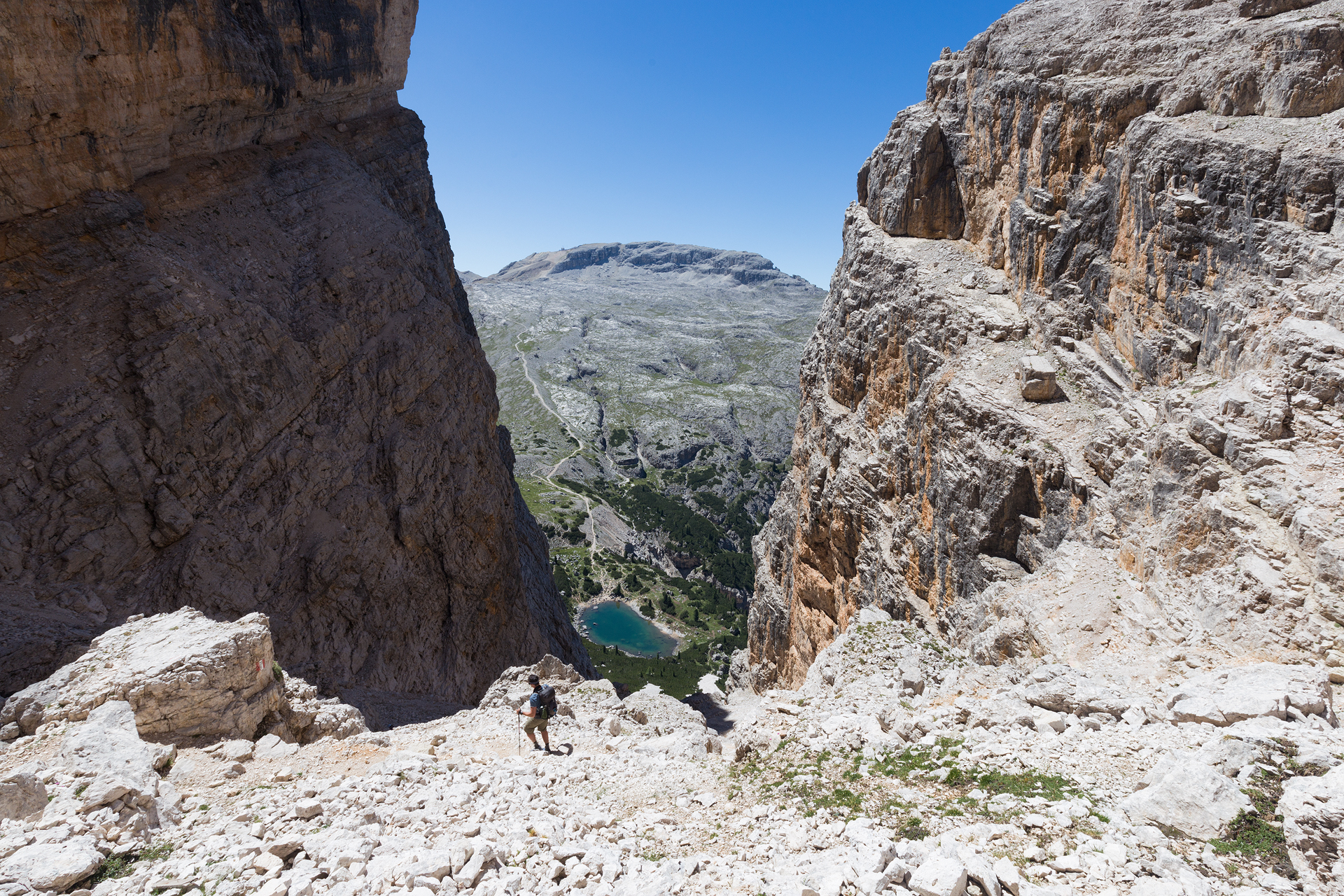hike the alta via 1
the rundown
Duration: 8 days/7 nights
Distance: 120km (75 miles)
Elevation gain: 6,705m (22,000')
Trailhead: Lago di Braies
Every summer Alex and I like to take one long backpacking trip. When we were in the planning process for 2017's trip I stumbled across some photos of the Dolomites. Alex and I had talked about this picturesque region before and we both mentioned our desire to visit it. It felt exactly like what we were looking for so I began researching hikes in the Dolomites. I noticed the Alta Via 1 showed up on nearly every website I found. There are eight Alta Via routes in the Dolomites but number 1 is the most popular. After reading about the trail and talking it over with Alex we decided it was the one! We would spend 8 days hiking the Alta Via 1.
planning your trek in the dolomites
Are permits required? No. Reservations for the rifugios are also not required, however, I strongly recommend booking your rifugios in advance if you know where you want to stay each night. I booked all of my rifugios immediately after Alex and I decided to hike the Alta Via 1 way back in January. By the time July and our hike rolled around many of the most scenic rifugios, such as Lagazuoi, were already booked. Below are the rifugios Alex and I stayed at.
Rifugio Nuvolau - named after the Italian word for cloud, "la nuvola"
How to get to the trailhead: This hike begins at Lago di Braies in northern Italy. The nearest airport is Venice. Since this is a thru-hike and renting a car isn't a feasible option you will likely use public transportation to get to the starting point. We took three buses and caught the first one right outside the airport.
After you exit the baggage claim area in Venice take a left and find the ATVO bus ticket line and purchase a one-way ticket on the Cortina Express. The line runs four times per day and costs 25€ per person. It takes just over two hours to get to Cortina and there is Wifi on the bus.
In Cortina Alex and I stayed at Hotel Villa Blu, which was a ten minute walk from the bus station. There are plenty of hotels near the bus stop if you want to stay in Cortina or you can choose to continue onto Dobbiaco. Transfer to a SAD bus (line 445), the bus should have "Dobbiaco" displayed on it. You can buy a 5€ ticket onboard. The ride to Dobbiaco is 50 minutes. In Dobbiaco you will transfer to SAD line 442 to Lago di Braies/Pragser Wildsee. This ticket also costs 5€ and it takes 27 minutes to get to Lago di Braies.
How to get back to Venice: The hike traditionally ends at the La Pissa bus stop. Here you can catch a 20 minute bus ride to Belluno. You can buy your ticket on board for a small fee. Once you are in Belluno you can transfer to another bus or train back to Venice or many other destinations!
When to go: July and August are the best months to hike the Alta Via 1. August is typically when Europeans take holiday so I would recommend hiking in July.
Special notes and FAQ:
I don't want to stay in the rifugios, can I camp? Camping is not allowed along a majority of this route.
Is it safe to solo hike this route? This is a very popular route for both thru-hikers and day hikers so you will never feel truly alone. This combined with the fact that you stay in warm, comfortable rifugios make this the ideal route to hike solo.
Where do I get water? There are a few streams you can filter water from along the way but each rifugio sells water bottles (for a couple euro each). Unfortunately, the running water in most of the rifugios is gray water and not drinkable.
Do I have to reserve the rifugios ahead of time? I highly recommend reserving your rifugios as soon as you know you want to hike this route. The most popular ones (eg. Lagazoui) fill up fast!
What if I don't want to hike the whole thing? Not a problem! There are plenty of entry and exit points along the way you can use to access a short section of the Alta Via 1. I recommend buying this book, it was an invaluable resource for me when I planned my trip and I know it will be helpful for you as well!
What is your favorite section? I preferred the first portion: Lago di Braies to Rifugio Citta di Fiume. This section covered the high, rocky mountainous region whereas the second portion descended into lush forests and valleys. Don't get me wrong, both sections were incredibly beautiful, but being a sucker for mountains I loved the first portion the most.
Can I go in May or June? Doing the Alta Via 1 early in the season is a huge undertaking, there will likely be a significant amount of snow and ice along the route and new snow could even accumulate while you hike.
How many snacks should I bring? We brought plenty of snacks but barely touched them! The meals provided at the rifugios are quite large so Alex and I ate big breakfasts and that was enough to get us to the next rifugio where we bought a small snack or a beer before eating another big dinner.
Do I need to learn Italian? While many people in larger cities (eg. Venice) speak English, and all the rifugios have at least one employee who speaks English, there are plenty of people you will encounter on the trail who do not speak English so I do recommend learning common phrases in Italian. Alex and I got turned around on the trail twice and both times the people who were able to help us didn't speak any English, luckily I had learned enough Italian from my Duo Lingo lessons that I could communicate with them and they helped us on our way. Bonus points if you want to learn some German phrases as well, as on the northern portion of the trail is seemed German was more common than Italian.
Gear to pack:
35-45L backpack
Trekking poles
Sturdy hiking boots or trail running shoes (whichever you feel more comfortable in)
Water bottle
Sleeping bag liner (required by rifugios)
First aid kit
2 pairs of shorts
Rain jacket, fleece mid-layer, insulating layer
Sleeping clothes
Sunglasses
Brimmed hat
"Trekking in the Dolomites" by Cicerone Press
Maps! You can buy the Tabacco Maps once you arrive in Italy or you can use their app.
031 Pragser Dolomiten – Enneberg/ Dolomiti di Braies – Marabbe
03 Cortina d’Ampezzo e Dolomiti Ampezzane
025 Dolomiti di Zoldo Cadorine e Agordine
024 Prealpi e Dolomiti Bellunesi

















